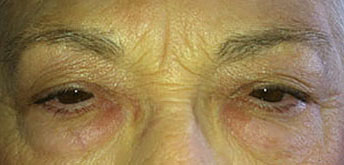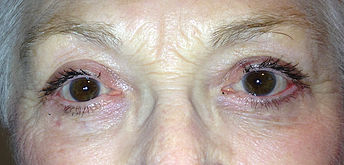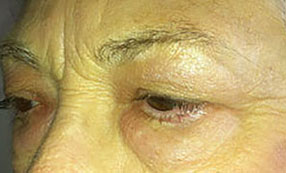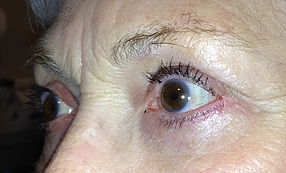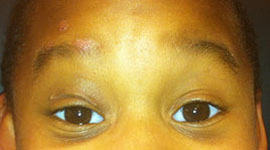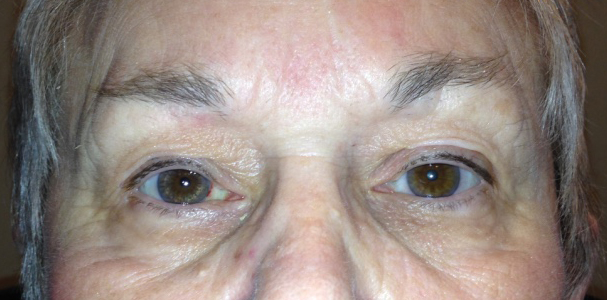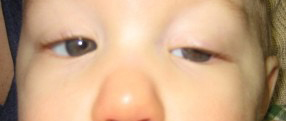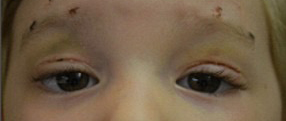Ptosis of Eyelids (Drooping)
Bilateral Upper Eyelid Blepharoplasty, Ptosis Repair, and Bilateral Lower Eyelid Blepharoplasty
Right Upper Eyelid Congenital Ptosis Repair via Frontalis Sling Technique Using Fascia Lata Harvested from Patient's Leg
Right Upper Eyelid Ptosis and Right Upper Eyelid Ptosis Repair
Bilateral Congenital Ptosis Repair via Frontalis Silicone Sling Technique
Bilateral Upper Eyelid Ptosis Repair in Patient with Prosthetic (False) Left Eye
Ptosis is a condition that occurs when one or both upper eyelids droop and the edge of the upper eyelid falls towards or over the pupil. Ptosis is usually caused by stretching or thinning of the tendon between the muscle that raises the eyelid and the eyelid itself. With stretching or thinning, the muscle that normally raises the eyelid has to work harder to lift it. This leads to symptoms of eyelid and forehead muscle fatigue, and eyelid heaviness. Other, less common causes of ptosis are nerve or muscle damage from any cause, various types of eyelid surgery, infection, muscle weakness, and systemic diseases such as stroke and tumors behind the eye, myasthenia, hypertension, thyroid disorders and diabetes. Children can be born with congenital ptosis; the muscle is abnormally stiff and does not function well. This condition usually lasts until it is surgically corrected. Ptosis surgery is not the procedure of choice for removing excess fat and skin in the upper eyelid. Under certain circumstances it can be combined with the operation known as blepharoplasty when fat and skin removal is an added goal of surgery.
To correct ptosis, the surgeon needs to make an incision or cut the skin of the upper eyelid in order to reach the muscles and tendons. The surgeon chooses where to make the incision based upon what treatment the eyelid needs. With the front or anterior approach, the surgeon makes an incision in the skin in the upper eyelid crease or fold in order to reach the muscle and tendon; if there is no eyelid fold, one can be created when the incision is made. The anterior approach allows the surgeon to trim excess skin and fatty tissue from the upper eyelid if needed during the surgery. If no skin or fat needs to be removed, the surgeon can raise the eyelid through an inside approach by placing the incision on the inside or moist part of the upper eyelid; with this approach, there is no cosmetic scarring. If the muscle is not strong enough to lift the eyelid, the surgeon must create a “sling” by connecting the moving eyelid to the frontalis muscle in the forehead.
The droopy eyelid is like a curtain that blocks the view. Patients with ptosis frequently notice that they have less peripheral or side vision, particularly when looking up. The more ptosis, the greater the peripheral vision loss. When the eyelid is raised, either manually by hand, or surgically through one of the approaches described above, the blockage is removed and the eye can see. Ptosis surgery only corrects vision loss due to droopy eyelids. It does not improve blurred vision caused by problems inside the eye, or by visual loss caused by neurological disease behind the eye. To prevent amblyopia or poor visual development in children born with congenital ptosis, the surgery needs to be done early in life.
Patients with ptosis report that droopy eyelids make them look and feel “tired.” When the eyelid is raised in ptosis surgery, patients usually prefer the new eyelid position, and feel it improves their appearance as well as their peripheral vision. When only one eyelid is raised, it may affect how the eyelid on the other side looks. If this happens, ptosis surgery on the other side may be needed. If the position and shape of the eyelids do not match, additional surgery may be needed.
